
 |
|||
| |
|||

Defenders Christine Nannicelli (17), a junior, and backfield teammate Morgan Kuhn (3), a senior, high five. Photo by Brian Kersey (WCAS99)
Sidebars: The Winningest Coach in Northwestern History Tennis: A Great Match for Katrina Adams Women Inductees into Northwestern's Athletic Hall of Fame


Junior Cristelle Grier Photo by Kelvin Ma (J04)


Junior Julie Lipinski leaps over Wisconsin's Molly Meuer during Northwestern's 2-1 overtime win over the Badgers. Photo by Brian Kersey (WCAS99)


Juniors Christie Gardner, left, and Julie Purcell chat with a young fan during Wildcat Women's Sport Weekend. Photo by Brian Kersey (WCAS99)


Softball player Eryn Manahan, a Northwestern graduate student, swings a bat. Photo by Kelvin Ma (J04)
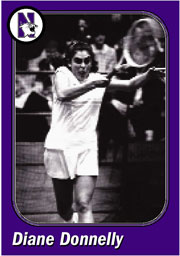
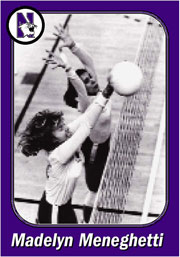
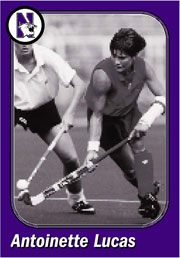
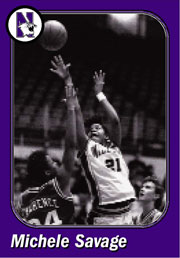
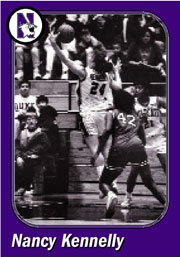
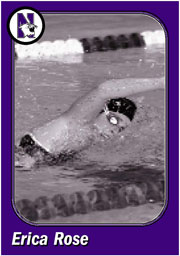
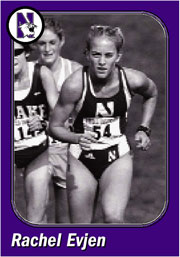
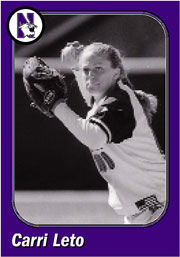
|

When Julie Calahan Bauer (SESP81) arrived at Northwestern in fall 1977 as a basketball recruit, she was surprised to find that there were no practice uniforms for the team. Forced to supply their own T-shirts and shorts, the squad complained to the equipment manager. In short order, they got more than they bargained for. The manager was able to scrounge up some hand-me-downs from the men’s teams. “They decided we would get clothes, but we wouldn’t get anything special,” Bauer recalls. “Each day in your locker you got a pair of gray shorts, a gray T-shirt, sometimes with the sleeves ripped off by a football player who had worn it, a pair of socks and a jockstrap! It was amazing what you could do with that piece of equipment.” Bauer joined the varsity team in its third year and five years after the historic passage of Title IX of the Education Amendments of 1972, the landmark legislation that banned sex discrimination in academics and athletics and other educational activities and programs. The law mandated that women athletes be provided benefits and opportunities equivalent, though not identical, to those the men received. Title IX leveled the playing field and set Northwestern women’s athletic teams on a path that has led to tremendous success in the past three decades. Women athletes began playing at Northwestern in the late 19th century. They donned their long skirts and high-collared blouses and actually played basketball three years before the men took up the sport. The Women’s Athletic Association was founded in 1911. In the absence of varsity athletic competition, many women in the 1920s and 1930s participated in Olympic sports, and Northwestern sent several women to the Olympic Games, including gold medal winners Sybil Bauer (C26), in swimming, and Elizabeth “Betty” Robinson Schwartz (SESP34) and Annette Rogers Kelly (SESP37), in track and field. All three are in Northwestern’s Athletic Hall of Fame (see list). The road to today’s roster of women’s varsity teams has been somewhat uneven. Both the men’s and women’s track teams were eliminated 16 years ago. Women’s cross country was added in 1976 and dropped 11 years later. Similarly lacrosse was introduced as a varsity sport in 1982 and dropped in 1993. Since then Northwestern has steadily increased the number of women’s teams, adding golf in 1992, soccer in 1994 and reinstating cross country in 1998 and lacrosse in 2002 after several women’s club teams expressed interest in having their teams elevated to varsity status. Today the school has 11 varsity women’s sports: basketball, cross country, fencing, field hockey, golf, lacrosse, soccer, softball, swimming and diving, tennis and volleyball. The men compete in eight varsity sports. Now the number of women student-athletes at Northwestern nearly equals the number of their male counterparts, despite there being nearly 100 men on the football team. Today more than 200 women participate in the 11 varsity sports. “We have a very strong women’s athletic program,” says Director of Athletics and Recreation Mark Murphy, “more so than the men’s, though the women have more chances because they have more teams. Our female athletes are well-respected on campus. The administration, faculty and other students really appreciate their success.” Learning the Ropes Mary DiStanislao (GSESP80, KSM89) was the first coach of the basketball team when it gained varsity status in the 1975–76 season. Though she drew some of her first players from a women’s club team on campus, the experience of starting up a new program from scratch was challenging. “To recruit high school girls was new for everyone,” she says. “I went to men’s coaches and said, ‘How do I do it?’” Her team shared a locker room in the basement of Harold Anderson Hall with several other women’s squads, and the court time was split with the men’s team. “Tex Winter was the men’s coach and was such a great guy,” DiStanislao says. “He wasn’t threatened at all. He wasn’t territorial. We shared everything.” Calahan Bauer, who played for DiStanislao, held the record for the most points scored by a Northwestern woman until her total was passed in 1984–85 by Anucha Browne Sanders (C85). Sanders tallied 2,307 career points. It was not the only milestone Sanders would reach. Sanders set school records for most points scored, free throws made, rebounds and blocked shots. She was recognized as a Kodak All-American, Street & Smith All-American and was Big Ten Player of the Year twice. The Daily Northwestern named her one of the top 10 Northwestern athletes of the 20th century. While Sanders dazzled on the court, Lisa Ishikawa Sliwa (McC88) was setting records on the softball field that may never be broken. During her freshman year in 1984 she threw five no-hitters, won 33 games (tied for best in the nation) and pitched 22 shutouts. She helped lead the team to the Big Ten title and a third-place finish in the NCAA Women’s College World Series. Northwestern, under legendary coach Sharon Drysdale, would return to the World Series the following two years. “Looking back on that first year, it must have been hard for the rest of the team,” Sliwa recalls modestly. “If you think about it, I didn’t really have a direct impact on our winning a game. I could only help prevent us from losing. The rest of the team scored runs so we could win.” Sliwa’s career statistics for earned run average, wins, complete games, shutouts, strikeouts and innings pitched still stand. She, too, earned a spot in the Daily’s list of greatest school athletes. Student-athletes at Northwestern face the challenge of balancing athletics and academics. And they find that balance where they can. Sliwa remembers the time her freshman year when coach Drysdale administered a chemistry test to her and a classmate in a hotel room while their teammates relaxed around the pool. “An advantage of attending a school like Northwestern is that we didn’t have physical education majors,” Sliwa says. “We had girls majoring in engineering, premed and prelaw. We usually traveled in two vans for away games. One van was designated as the ‘party’ van, where they played music and talked. The other van was designated as the ‘study’ van, where it was quiet and everyone had flashlights so that they could read when it was dark!” Sliwa and her teammates played hard and studied hard, but they also had some lighter moments. “I remember one game where our catcher came out to the mound and told me to throw a wild pitch so she could check out the guys behind the backstop,” Sliwa says. “And the year Debbie Gannon, our assistant coach, gave us toy pigs because she said the difference between ham and eggs is that the chicken is involved but the pig is committed. That year we all carried our little pigs to all the games.” Gretchen Scheuermann (SESP96) was the third woman named to the Daily’s list of best athletes of the 20th century. She led the field hockey team to the Big Ten title and the semifinals of the NCAA Division I Field Hockey Championship in 1994. That year she received the Honda Award as the top collegiate field hockey player in the nation. University Support Fosters Success In recent years the University has made a strong commitment to its athletes, male and female, with the construction of several state-of-the-art sports facilities. The Ivan Combe Tennis Center, Gleacher Golf Center and the Leonard B. Thomas Athletic Complex, where the soccer, field hockey and lacrosse teams play, each factored into the teams’ successes. The Combe Center, “is a good example of a facility that has been a tremendous help to a program,” says Murphy. “Given our weather in the spring we really needed an outstanding indoor facility to compete against the top programs from the South and West. Similarly, the Gleacher Center has transformed our golf programs. All of these facilities are very helpful to us in trying to attract top student-athletes to Northwestern.” The results are clear. The tennis team won the Big Ten Championship for the sixth straight year in spring 2004. In fall 2003 the doubles team of Jessica Rush (WCAS04) and Cristelle Grier, a Weinberg College of Arts and Sciences junior from London, won the Intercollegiate Tennis Association National Indoor Championship. They were the first Big Ten pair ever to win that title. Grier and Rush also smashed the school record for doubles wins in a season with 41. For the second straight time, Grier, who also set a new singles standard for wins (40), was named Big Ten Player of the Year. Claire Pollard was named the conference’s Coach of the Year for the second time. For all of the individual achievements she earned at Northwestern, Rush is proudest of the four team championships she was a part of. Grier agrees. “Obviously when you’re out there, you’re alone,” she says. “But everything you do is for the team. Your results contribute to something greater than yourself. It’s very gratifying.” The two players follow in some pretty big footsteps. The women’s team took the Big Ten Conference Championship in 1985 and 1986. The doubles pair of Diane Donnelly Stone (C87) and Katrina Adams (C89) (see “Tennis: A Great Match for Katrina Adams”) were NCAA Champions in 1987. And Katherine Nasser (WCAS00), in 1998, and Marine Piriou (WCAS03), in 2002, won Big Ten Player of the Year honors. Last year the golf team enjoyed continued success when it made it into the postseason for the fourth time in the past five years. The golfers narrowly missed a chance to qualify for the NCAA Division I Women’s Golf Championships, but the future is filled with promise. Alice Kim, a Weinberg sophomore from Los Angeles, was named Big Ten Freshman of the Year, edging out teammate Kelly Robb, a Weinberg sophomore from Concord, Mass. Youth will also serve the volleyball team, which finished the 2003 season with the program’s best record in 15 years and a second straight trip to the NCAA Tournament. Northwestern teams were Big Ten Conference champions in 1983 and 1984 and have produced several standout players. Madelyn Meneghetti (SESP85) played for the U.S. National Team in 1985 and was named to the Big Ten All-Decade Team. Patty Walsh Iverson (WCAS83) was a three-time All-American and member of a Big Ten All-Decade Team. Of the honors she received, Iverson says they “acknowledge the important contributions we made in helping women’s athletics get off to a very successful start. I’m very proud of representing those women with whom I played. The experience empowered us as student-athletes and empowered us as women.” Over the years Northwestern’s field hockey team has played at the highest level, finishing first or tied for first in the Big Ten five times between 1983 and 1994. Jennifer Averill (SESP87) was named National Player of the Year in 1986, and Antoinette Lucas (WCAS92) played on the 1996 U.S. Olympic team. Last year’s team earned a different distinction. Ten players were recognized by the Big Ten and the National Field Hockey Coaches Association for academic excellence, the highest number of individuals to receive those honors in the program’s history. The Big Ten honored soccer standout Erica Westrich (WCAS00) twice during her career, naming her Freshman of the Year in 1996 and Player of the Year in 1998. Northwestern went to the NCAA Championship tournament both years. Like many athletes, Westrich and her teammates had certain rituals they followed. “It would range from certain songs to listen to during pregame, old T-shirts worn under our jerseys, unique ways of taping up socks, specific ways to wear your hair,” she says. Westrich’s rirtual involved food. “I used to eat some of the strangest things for pregame meals,” she says. “I never enjoyed breakfast before games, but I used to finish whatever I’d have with some sort of pie, preferably pumpkin. Since we were in season during the fall, I usually ended up finding some place on the road that would serve me pumpkin pie at 8 in the morning!” Several of Northwestern’s most accomplished basketball players played for coach Don Perrelli who took his teams to six postseason tournaments in 15 seasons. Street & Smith All-American Michele Savage (SESP93) and teammate Nancy Kennelly (WCAS93) led Northwestern to the Big Ten title in 1990. Kristina Divjak (C99, GC00) was named honorable mention All-American by Street & Smith and Kodak in 1998. Building the Buzz Sports like golf, field hockey and soccer are nonrevenue-generating sports. At Northwestern, basketball and volleyball are the only women’s programs that charge admission for their games, and that revenue is minimal. The challenge for Northwestern, and most universities, is how to promote those sports. Chris Boyer, associate athletic director for external affairs, takes an approach “that is grass roots and makes our athletes and coaches as accessible as possible. We target Northwestern alums, local families and youth participating in the same sport we’re trying to market,” he says. Athletes go into the community and conduct clinics and sign autographs. Direct mail is used to invite people to sporting events, and, once there, fans are treated to music, entertainment and promotional items. “We try to make it as family-friendly as possible,” says Boyer. In the fall and spring the department organizes Wildcat Women’s Sport Weekend. Events include clinics for kids, health seminars, autograph sessions and prize giveaways. It’s a way for fans and potential fans to connect personally with the teams. Two years ago the athletics marketing department organized its first Wildcat Field Trip. The women’s basketball team played a regular season game at McGaw Memorial Hall at noon on a weekday, and students from the Chicago Public Schools and North Shore schools were invited. An educational component, emphasizing staying in school and physical fitness, was included. Nearly 3,000 elementary school students showed up and rocked the house. “The decibel level of that many grade-school students was incredible,” says Boyer. “The goal, early in the season, was to get a group of kids to come, enjoy themselves and go home and tell their families.” The teams get additional encouragement from Center Court, a booster club formed after the implementation of Title IX to support women’s athletics. The group assists with the women’s sports weekends, hosts an annual sports banquet, provides sendoffs (complete with pompoms) for teams heading out on road trips, and tries to get to as many games, meets and matches as they can. It’s a little hard to hear the cheers when you’re underwater, but that hasn’t held back the swimming and diving team. For 17 of the past 20 years at least one member of the team has been Big Ten Champion in her event. Northwestern’s women’s squad has been ranked in the top 15 in the country 10 times. In June Erica Rose (WCAS04) won USA Swimming’s 10K Open Water Championship for the third year in a row. Later that month she won the title at the Pan American 5K Open Water Championships. The cross country team has been making improvements since being reinstated as a varsity sport in 1998. They received a bid to the NCAA Cross Country Championship in 2002, and last year Diana Hossfeld, a School of Communication senior from Newport Beach, Calif., earned All-District and Academic All-American honors. Rachel Evjen (SESP03), a member of the 2002 NCAA qualifying squad and one of the Wildcats’ most decorated runners, returned to Northwestern as an assistant coach in July. “She will be an asset to the program in many ways,” says head coach Amy Tush. “She was a tough, smart competitor and will make a great coach.” Heavy Lifting An early Northwestern catalog mandated that “every young lady is required to walk half an hour a day.” That might have been bold for the time but things have certainly changed. The female athletes today are getting in shape and staying fit in ways that would stagger the genteel ladies of the 19th century. “Our training is pretty rigorous,” says volleyball standout Drew Robertson, a Weinberg senior from Long Beach, Calif. During the season she and her teammates lift weights twice a week for an hour at the Byron S. Coon Sports Center. In the offseason it’s four times a week, starting at 7 a.m. “We run up and down the stadium stairs at Ryan Field, do short distance sprinting and jump training to improve our verticals,” she says. “It’s pretty heavy lifting.” For Kelly Amonte Hiller, coach of the resurgent lacrosse team (see “Northwestern’s Dream Team”), the key is to not overdo the workouts. “We want to peak for the NCAA tournament,” she says. “We have to strike a balance between trying not to burn them out and keeping them fit to compete at the highest level. Lacrosse is definitely a sport for a real athlete.” Real athletes seem to be what Northwestern has in abundance, especially in women’s sports. Former Senior Associate Athletic Director Ken Kraft (SESP57, GSESP59) says that “television and Title IX are the most dramatic things that have impacted athletics in the past 50 years.” Title IX opened the door, and a lot of athletes, coaches, trainers, administrators and fans walked through it. The NCAA ran a television commercial during this year’s basketball tournament that said, “There are 360,000 student-athletes in the country, and almost all of us are going pro in something other than sports.” That is particularly true of women athletes and Northwestern athletes. However, softball player Carri Leto (C04) became the first Northwestern female athlete ever drafted by a professional sports team when she was chosen this year by the New York/New Jersey Juggernaut of the National Pro Fastpitch league. “From the female athlete’s perspective, the carrot of becoming a professional isn’t there,” says Murphy. “They tend to be more concerned about the quality of their education and are participating primarily for personal enhancement and goals. The team is very important to them.” Calahan Bauer feels the same way. “All of the women I played with were good athletes and could have played any sport,” she says, “but basketball was one of the few sports available to us. It was a fun time because everyone played for the love of the game.” For Westrich, the team was more important than any individual recognition. “It was a great honor to be named Big Ten Freshman and Player of the Year,” she says. “And honestly, both times I was completely shocked. Personal awards were never a motivating factor for me. And I do believe my teammates played a big part in those honors I received. “It was one of the best compliments I’ve been given,” she adds, “but I’d give back both awards in a heartbeat to have a Big Ten Championship ring or, better yet, an NCAA Championship ring.” Terry Stephan (GJ78) is a freelance writer based in Chicago. Did you enjoy this story? If you have any questions or comments, please e-mail the editors at letters@northwestern.edu. Northwestern 1800 Sheridan Road Evanston, IL 60208-1800 Phone: 847-491-5000 Fax: 847-491-3040 E-mail: letters@northwestern.edu Last updated Tuesday, 27-Jun-2023 15:55:28 CDT World Wide Web Disclaimer and University Policy Statements © 2002 Northwestern University |